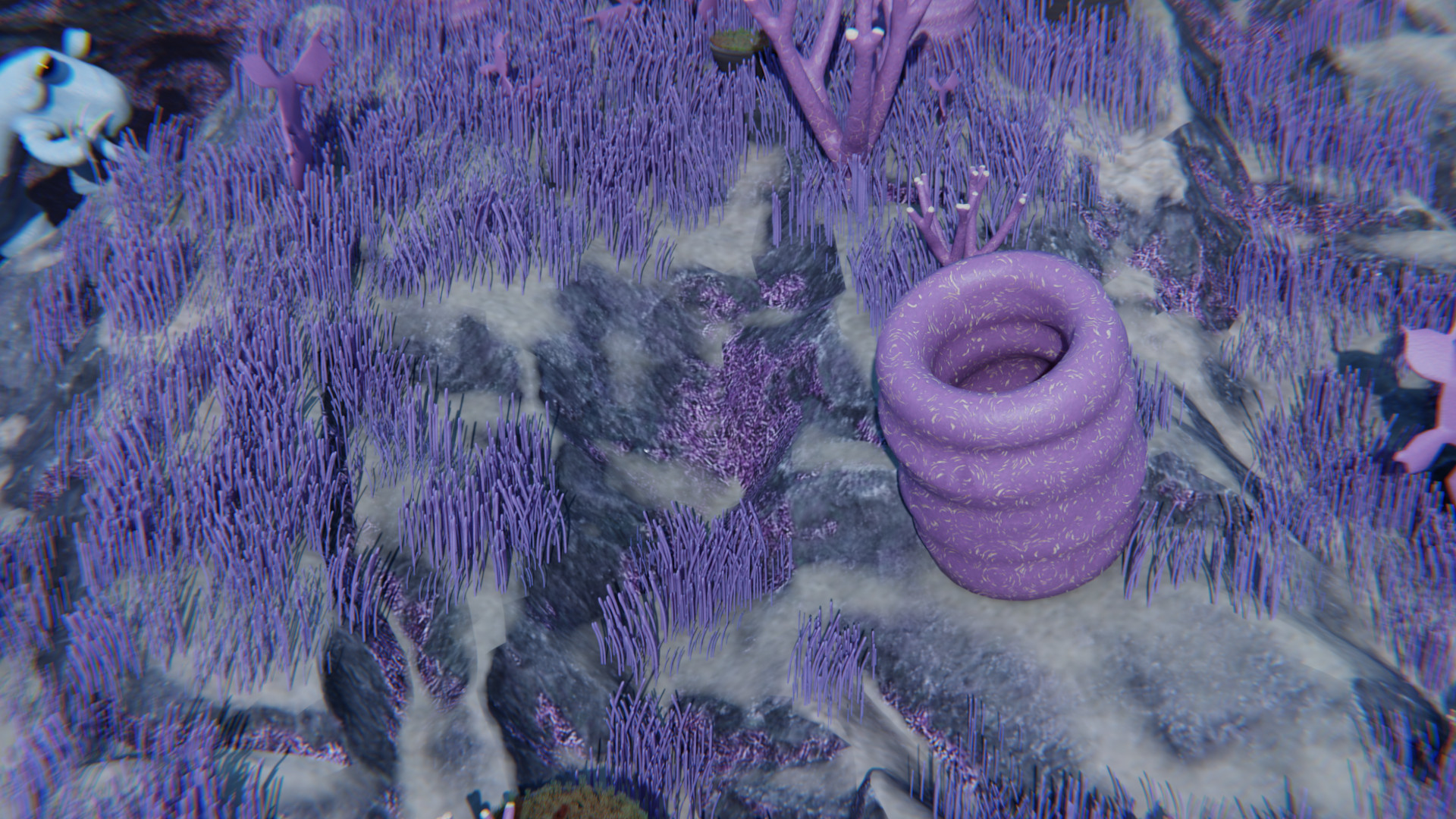Tube Octacoral
The tube octacoral is a reef building organism that provides a home for many other organisms, who return the favor by defending their home from browsers who might like to make its soft outside a snack. [Creature design by SeanDraws]
Basic Information
Anatomy
Unlike other octacorals in genus Polyfungos, Fistulafungos does not have discrete pollies, and its skeleton is thin but distributed throughout its body. It grows in a tube shape, and the center of the tube is often home to some other organism. During the mating season buds will develop at the top of the tube. These release haploid isogamous spores both into the water column as well as onto the surface of the octacoral, the former may meet other tube octacoral spores in the water column, while those stuck to the outside may be picked up by passing organisms and brought to nearby other tube corals.
Genetics and Reproduction
Tube octacoral reproduce both by fragmentation, and via spores. Fragmentation occurs when a piece of octacoral is broken off, it secretes an adhesive agent from the open wound, which dries and forms a scab on the piece still connected, but for small broken off pieces, the adhesive means that if they are lucky, it will attach to a rocky outcrop, where it can start growing again. Having more mass is more helpful than having less, as this can help it reach full size faster. Octacoral is heavy enough that pieces sink to the bottom, but light enough to be carried a little way by the current first.
Sexual reproduction his is the primary method of reproduction for all Octacoral species. Mature and healthy Tube octacoral will produce clumps of buds on the rim of the tube, these clumps contain up to a hundred spores inside a protective shell. A single octacoral will have a few hundred to a few thousand clumps. When conditions are just right, all the tube octacorals release their spores into the current at the same time, using water chemistry, temperature, and light levels of both the sun and moons to synchronize their release with each other. filling the sea with millions of buds in one go, this overwhelms the many predators that eat the buds, as each bud has a small package of nutrients for the young coral, making them an ideal snack, and making spawning a veritable feast for the reef dwellers. Spawning’s are loosely based on time of year, but if the triggering conditions don’t happen, they won’t spawn that year, and they might happen at a different time of the year or multiple times in one year if the conditions are met more than once.
The spores float in the current, but should two meet, they will fuse and splice there DNA.
Ecology and Habitats
Octacoral provides a habitat for hundreds of unique species that rely on the reefs for shelter, such as the rib fish and Thanatodon ýfalos. The webs of hard skeletal matter, and the caves formed in them, are the perfect hiding spots for small organisms and ambush predators alike. The coral also supports some organisms more directly, such as the fortress-misa who use the coral for nest materials, using broken off pieces of coral to build and disguise their nests.
Dietary Needs and Habits
Octacoral requires very specific conditions to grow. Firstly it requires a rocky attachment point, without which nothing else will matter, as octacoral is completely incapable of growing on lose substrate like sand or gravel. Secondly, octacoral requires constant tropical sunlight; low light levels will stunt its growth or even kill it. Due to octacoral storing little nutrients as a deterrent against predation, it needs a constant stream of energy to keep it alive, even a few heavily over cast weeks in a row can cause reefs to die back substantially. Ph and water hardness is also very important; octacoral thrives in hard water with a PH from 8.2-8.5 and will start to die at 7.2. Events that lower PH rapidly such as volcanic activity, and the deaths of large creatures leaving behind an excessive amount of decomposing material, can cause die backs. Combinations of Ph drops and low sun light can cause major die offs that turn the purple/pink reefs bone white.
Biological Cycle
Upon death an octacoral leaves behind its skeleton, once all other organic materials have rotted away, the skeleton is rough and porous, due to the vessels and pours in it for fluid transport and storage. These rough skeletons are the perfect attachment point for more octacoral, and the skeletons leach minerals into the water, raising PH and water hardness, making it ideal for more octacoral growth, and so reefs that experience large die backs provide the ideal environment for a new generation of octacoral. For this reason most reefs are constantly waxing and waning over the decades. Also, because of octacoral’s ability to grow from the skeletons of the previous generation, it is able to colonize once barren sand dunes, turning them into moderately sized reefs over the course a century or so, all it takes is a single exposed boulder to appear and become home to an octacoral, then the generations of octacoral will build on each other, until a new reef is created.











Comments